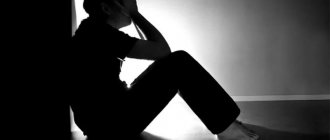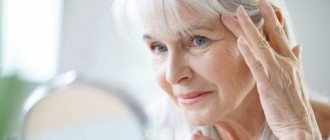Hysterical neurosis or hysteria is the most common reversible type of mental disorder, ranking second after neurasthenia. Most often, women and children suffer from the disease. But recently, the growth of the disease has been steadily decreasing, which is facilitated by the increasing culture of the lifestyle of the world's population.
The term “Hysteria” comes from the ancient Greek word “hister”, which means “uterus” - until now, medical scientists believe that one of the causes of the disease is a dysfunction of the female reproductive organs, namely the uterus, which explains the prevalence of pathology among representatives of the beautiful floor. In addition, the symptoms of pathology are often perceived as a consequence of a person’s uncooperative character, bad manners and bad behavior.
What is this?
Hysterical neurosis (HN) or hysteria is one of the forms of such a mental disorder as neurosis and is always accompanied by the patient’s desire to attract as much attention as possible to himself.
At the same time, the variety of symptoms of the pathology is amazing: the patient loses vision, hearing, sensitivity and even motor activity, and experiences attacks combined with convulsions. At the same time, the patient strives to demonstrate hysterics precisely in the presence of others, to let those close to him know how bad he feels, in general, he works “for the public.” Hysterical neurosis gives the patient the ability to simulate quite a few symptoms of serious diseases of the nervous system. One of the great doctors even called this disease “the great malingerer.”
So how can you determine whether the patient is really sick or whether he is skillfully manipulating others?
Diagnostic measures
If the first signs of a pathological process occur, it is recommended to immediately consult a doctor. If the patient has no organic changes and there are corresponding complaints, then he is diagnosed with hysterical neurosis.
If you suspect a pathology, it is recommended to consult a neurologist. The specialist will take a history and examine the patient, which will allow him to make a preliminary diagnosis . If a child under 4 years of age is examined, then the fact of the occurrence of hysterical attacks is taken into account if he wants to achieve something.
If there is a need to confirm or refute certain organic disorders. For movement disorders, computed tomography of the spine and magnetic resonance imaging of the spinal cord are recommended. These diagnostic techniques. If there is a need to determine or refute cerebral vascular pathologies, then the following is prescribed:
- Vascular angiography;
- Doppler ultrasound;
- Rheoencephalography.
electroencephalography and are recommended .
Diagnosis of the pathological process must be comprehensive. This will allow you to refute or confirm the diagnosis, and in the second case, prescribe effective treatment.
In psychiatry
Modern psychiatry uses the term “hysterical neurosis” to define a state of the human nervous system in which the symptoms are based on somatovegetative, sensory, motor and affective disorders. The emergence of mental infantilism as a consequence of internal conditions and family upbringing plays an important role in the etiology of the disease. In addition, hysterical personality traits, also inherent in the disease, mean egocentrism, an insatiable thirst for not only constant, but also increased attention (admiration, reverence, sympathy and surprise).
The pathogenesis of such conditions is quite complex and has not been fully disclosed; the complexity is the variety of hysterical disorders and the similarity of hysteria with a disease such as schizophrenia - timely and accurate diagnosis of the patient’s condition makes it possible to differentiate the pathology and carry out corrective treatment.
Treatment of hysterical neurosis
Treatment should begin only after the diagnosis has been accurately established and the type of hysterical neurosis has been designated. Self-therapy is not allowed.
Important! Histrionic personality disorder is not always treated within the walls of a hospital. If a favorable atmosphere is created at the patient’s home, recovery can occur within the family circle.
Pharmacy medicines
To reduce the frequency and duration of hysterical seizures, drug therapy is prescribed:
- If a patient complains of difficulty breathing, a lump in the throat during an attack, or convulsions, medications are recommended that reduce these symptoms.
- In case of excessive excitability, the patient is prescribed sedatives - infusion of valerian or motherwort, a course of tranquilizers or antidepressants.
- For persistent insomnia, the doctor prescribes sleeping pills.
Additionally, it is recommended to take restorative medications. Vitamin complexes will not interfere.
Occupational therapy
In addition to basic treatment, occupational therapy is indicated for hysterical individuals. This promotes the patient’s social adaptation and distracts from obsessive thoughts and worries about imaginary diseases.
Know! At the stage of occupational therapy, others should treat the patient as an equal. You should not focus on his problems and concerns.
Folk remedies
Traditional medicine helps restore the nervous system and reduce the frequency of hysterical attacks.
You can treat hysteria:
- herbal medicine - decoctions and infusions from a collection of medicinal herbs (lemon balm, chamomile, sage, mint);
- pine-salt baths;
- acupressure.
Attention! Any treatment methods at home can be used only after receiving the recommendation of a psychologist or psychotherapist.
Therapy should be carried out exactly as prescribed by the doctor. Dosages should also be observed. Even if the main symptoms have disappeared, relapses of neurosis can develop again.
In psychology
On the part of psychologists, there is a certain concept of hysterical neurosis, which is diagnosed with functional disorders of the nervous system as a result of severe psychological stress.
Psychologists define three types of neuroses: neurasthenia, hysterical neurosis and obsessive-compulsive neurosis. With such mental disorders, patients experience increased excitability, sleep disturbances, decreased concentration and a significantly increased reaction to any irritating factors. At the same time, the patient’s ability to work is almost completely preserved. But the development of the pathological process is accompanied by headaches, excessive emotional excitability, tearfulness, impatience and anxiety. Sometimes the process also affects some internal organs , significantly disrupting their normal functionality.
Important! In women, this psychological disorder is observed much more often than in men and has more specific symptoms: hysterical muteness and deafness, seizures and a significant decrease in libido.
Stages of development of neurosis
If neurosis is treated, then all the changes it causes can be eliminated. The disease leads to organic damage to the brain. Neuroses often have a long course. This largely depends on the individual characteristics of a person, as well as on how developed his adaptation mechanisms are that allow him to adapt to traumatic situations. Of no small importance is the character of a person, the degree of formation of psychological defense.
Neurosis has three stages. Each of them has a different set of symptoms:
- First stage.
The disease is just beginning to develop. A person experiences increased irritability and excessive excitability.
- Hypersthenic
or intermediate stage.
In humans, the excitability of the peripheral nervous system increases. - Hyposthenic
or final stage.
The patient is in a depressed mood all the time, drowsiness increases, he is apathetic, and shows no interest in life. This is due to severe inhibition of nervous system processes.
If neurosis is not treated, the disease will certainly affect a person’s behavior. The patient begins to understand that not everything is all right with him. Neurotic personality development occurs 6 months to 2 years from the first symptoms of the disease (if it is not treated).
Panic attacks during illness
Almost every person at least once in his life has experienced a feeling of strong fear - an intense release of adrenaline provokes an instant panic reaction. Panic attacks in hysterical neurosis are quite regular - the patient experiences a feeling of fear again and again, which is a sign of a serious disorder.
Panic attacks in a patient are always accompanied by profuse sweating, rapid heartbeat, a state of suffocation, fever, nausea and quite severe pain in the chest. The patient cannot cope with panic neuroses on his own. To accurately diagnose panic attacks, the regular occurrence of attacks is necessary.
Symptoms
An attack of hysteria is characterized by an extreme variety of symptoms, since thanks to self-hypnosis, patients can depict manifestations of any disease. Most often, the development of a hysterical attack is associated with emotional experiences.
A fit of hysteria is accompanied by the following manifestations:
- crying, screaming, laughing;
- pain in the heart area;
- feeling of lack of air;
- tachycardia (increased heart rate);
- hysterical ball (feeling of a lump rolling up to the throat);
- the patient falls or has seizures);
- hyperemia of the skin of the neck, face, chest;
- closing your eyes.
- patients may tear their hair, clothes, or hit their heads.
There are certain signs that distinguish a hysterical attack from other disorders: patients do not have bruises, a bitten tongue, an attack of hysteria never occurs in sleeping people, involuntary urination does not occur, the patient is conscious, he is able to answer questions.
Sensitivity disorders
Quite often, sensitivity disorders are observed: the patient is unable to feel parts of his body, move them, and sometimes intense pain occurs in the body. The lesion can be localized in the limbs, abdomen, and head.
Sensory organ disorder
In patients with a hysterical attack, vision and hearing may be impaired, visual fields may narrow, and hysterical blindness (both unilateral and bilateral) and hysterical deafness may develop.
Speech disorders
A fit of hysteria may be accompanied by hysterical aphonia (patients have no sonority of voice), muteness, chanting (pronouncing words syllable by syllable), and stuttering. The patient’s desire to enter into written contact is typical.
Movement disorders
During a hysterical attack, patients often experience the development of paralysis (paresis): paralysis of the muscles of the face, tongue, neck, unilateral paresis of the arm, trembling of the whole body or its individual parts, nervous tics of the facial muscles, arching of the body. You need to understand that during attacks of hysteria, it is not real paralysis that develops, but an elementary inability to make voluntary movements. As a rule, during sleep, hysterical paresis, paralysis and hyperkinesis disappear.
Disorder of internal organs
During an attack of hysteria, patients have no appetite, swallowing is impaired, psychogenic vomiting, nausea, yawning, coughing, belching, hiccups, pseudoappendicitis, flatulence, shortness of breath and simulating an attack of bronchial asthma are observed.
Mental disorders are associated with the patient’s desire to be the center of attention, excessive emotionality, tearfulness, psychotic stupor, lethargy, and a tendency to exaggerate. His behavior becomes demonstrative, theatrical and to some extent infantile.
Hysteria in women
Signs of neurosis in women are often similar to symptoms of other mental disorders. Only a psychotherapist can correctly diagnose the disease . Everyone can experience anxiety, worry, fear and uncertainty - such symptoms appear from time to time throughout life, as well as a feeling of intense joy.
Screaming is a manifestation of hysterical neurosis
Experts say that neuroses often arise due to a “conflict” between a person’s consciousness and his subconscious - most often women are susceptible to such contradictions.
For example: the need to go to a job you don’t like, or the impossibility of divorcing a husband (cheating or drinking) due to fear of public opinion, and even a large number of constant contradictions lead to the formation of hysterical neuroses with a wide variety of manifestations in the majority of modern women.
Symptoms of neurosis in women
Female neuroses have both physical and psychological symptoms - the manifestations of the symptoms completely depend on the functioning of the woman’s autonomic nervous system. Physical forms of neurosis are characterized by:
- lack of air;
- pain in the heart;
- sweating;
- disorders of the gastrointestinal tract (lack of appetite and intestinal irritation).
- memory impairment;
- decreased concentration and attention;
- headaches;
- constant fatigue;
- decreased performance;
- heart rhythm disturbances;
- a decrease (or vice versa, an increase) in blood pressure.
Psychological symptoms of ID in women manifest themselves as:
- unreasonable fears;
- depressive states;
- increased anxiety;
- panic attacks;
- obsessive actions;
- various phobias;
- mental disorders.
The most obvious signs of hysteria in women appear in the form of causeless tears or laughter, screaming, paralysis, temporary blindness and deafness, hallucinations and fainting.
Memo: Symptoms of ID in women
Important! The manifestation of symptoms is aggravated by the patient’s deliberate desire to intensify the symptoms and attract increased attention from others (which is determined by the clinical course of hysterical neurosis).
Causes
Women (as well as men) with a certain type of psyche are most often prone to the appearance of hysterical neuroses - excitable, suggestible, impressionable and overly emotional. The immediate causes of the development of ID are sudden stressful and conflict situations, problems that a person cannot cope with on his own. Freud very accurately determined that hysterical neuroses are always based on two factors: mental trauma (especially childhood) and sexual complexes.
Treatment
Hysteria is also called the “great simulator” - due to the variety of symptoms and even serious disturbances in the functioning of almost all internal organs.
But this is almost never confirmed by laboratory or instrumental studies. Only an experienced doctor, based on a set of signs of ID, can find discrepancies between real and “far-fetched” symptoms and accurately identify the disease. The essence of therapy for hysterical neurosis is to correct the mental state of patients using psychotherapy methods. Occupational therapy plays an important role in the treatment of such conditions. In some cases, in the treatment of IN, drug therapy with restoratives or tranquilizers is used.
Causes of hysterical neurosis
The reasons for hysteria may vary. This is a multifactorial pathology. An attack is provoked by anxiety, stress, and somatic illnesses. Often hysterical neurosis is a consequence of endocrine diseases.
In adults
Persons who have the following character traits are more susceptible to hysterical attacks:
- narcissism;
- selfishness;
- egocentrism;
- increased impressionability;
- infantilism.
The pathological development of the psyche can be influenced by lifestyle, certain events, illnesses and injuries:
- disability;
- loss of loved ones;
- somatic diseases;
- long-term use of large doses of alcohol or drugs;
- emerging dependence on sedatives.
In women, hysteria can develop as a result of psychological or physical trauma, due to frequent and excessive worries about family and friends, everyday problems and family scandals. Also, in the female part of the population, severe hysterics can be provoked by:
- premenstrual syndrome and menstruation;
- postpartum period;
- menopause.
Attention! If the psyche of an adult is weakened, then the slightest deviation from the usual course of life causes hysteria.
In children and adolescents
Hysterical neurosis in children occurs when parents pay too little or too much attention to them.
Other unusual situations can also cause an attack of emotional instability:
- parental divorce;
- the birth of another child in the family;
- family problems, misunderstanding on the part of relatives, total control, overprotection.
Hysterical neurosis manifests itself even in children from prosperous families. Contribute to its development:
- forced move to a new place of residence;
- transfer to another school without the child’s consent;
- sudden strong fear;
- allergic reaction.
If a child is injured during childbirth, its consequences may be emotional instability, a tendency to hysterics, and irritability due to headaches. In this case, you need to resort to preventive measures. The baby should be examined by a neurologist at least once a year and, if necessary, prescribed treatment.
In adolescents, violent reactions are observed during puberty, during the transition period - at 11–13, 16–18 years. In addition, tense relationships or quarrels with classmates, teachers, and parents provoke a strong psycho-emotional explosion.
Know! A minor incident, an unfair, in the child’s opinion, attitude, obsessive care or ignorance can make a teenager lose his temper.
Consequences
Like any other disease, hysterical neurosis without timely and competent treatment is complicated by such serious situations as:
- hysterical paralysis,
- astasia – abasia (impossibility of independent movement),
- complete associative behavior of the patient.
Let's talk about neurosis
Of course, experiences and the release of adrenaline are normal. The main thing is to try to evenly and measuredly distribute the load on the nervous system so that it has time to recover. We must not forget about positive emotions and physical activity.
Ways to relieve muscle tension during neurosis
There are many ways to instantly relieve muscle tension during neurosis, but they will be ineffective if the person is still under moral or mental stress, so before starting any action it is necessary to apply sedative measures. Each person has his own favorite and most effective ways of relaxation, but there are also generally accepted folk sedatives: valerian, motherwort, tea with mint, oregano or lemon balm, relaxing massage, warm bath with essential oils, etc.
After a person completely calms down and comes to his senses, muscle manifestations may go away altogether or at least become much less intense. To completely get rid of them, you then need to apply the most suitable folk methods for a particular case.
How to relieve a nervous tic
A nervous tic most often affects a person’s face: eyes, lips, cheeks, although it can manifest itself in any human muscles in the form of involuntary rhythmic contractions of long duration.
- This phenomenon can be removed by forcibly disrupting the rhythmic spasm of muscles, for example, the eye: by closing your eyes as tightly as possible for a while, by blinking very quickly for a long time.
- It helps well with a small massage of the area of the nervous tic, especially the contracting muscles,
- For nervous eye tics, you can apply acupuncture massage to the main points: at the bridge of the nose near the base of the eye, the opposite corner of the eye, the middle of the lower eyelid and the center of the area between the upper eyelid and eyebrow.
- You can stop the muscle by applying something cold to it: a piece of ice or a frozen product.
- You can relieve nervous tics of the eye and other facial muscles by using a contrast wash, alternately with cold and then warm water. Usually one time is enough, but it is necessary that the last wash be with warm water, as this will soothe, prevent hypothermia of the eyes and triadic nerves, and simply leave a more pleasant sensation than cold water.
- A relaxing bath will help relieve the tics of the muscles located below the face.
How to relieve increased muscle tension
Muscle overstrain can result in increased muscle tone, which is seen as unpleasant tension in one or a group of muscles, when there is no spasm or cramps, but it cannot be completely relaxed, or, conversely, in weakness, when overstrain results in muscle hypotension. For example, during an attack of hypotension in the hand, it may be difficult to hold even a cup of tea in the hand.
It doesn’t matter in what form the overstrain manifests itself: in the form of hypotension or increased tone, the cause for both phenomena is the same, therefore, the treatment will be the same.
- Massage without strong pressure in the form of gentle kneading, paying special attention to the problem area, helps to relieve muscle tension during neurosis in any situation.
- A warm bath, especially with relaxing essential oils, is an excellent way to relax the whole body.
- Even just swimming in the pool can have a beneficial effect.
- If possible, you can use a contrast shower or a Charcot massage shower, which not only perfectly soothes the muscles, but also brings a lot of positive emotions.
- One of the methods of treating muscle neurosis is acupuncture and acupuncture, based on influencing the main reflex points. Just to get the effect, you need to understand them at least a little or contact an experienced specialist, otherwise instead of a positive effect, only unpleasant sensations will remain.
- Neurologists and chiropractors use natural innate human reflexes for treatment. If a course of treatment by a specialist is not possible, in this case you can use video tutorials or visit a neurologist and ask him to explain the basic techniques.
How to relieve a cramp
A cramp due to muscle tension caused by increased physical activity usually affects the overworked muscle, and in the case of a mental one it can affect any motor muscle of the body or several at once. Relieving a cramp is problematic, since attempts to forcefully relax a muscle only lead to its strengthening and cause even more pain, so instead of unsuccessful attempts to relax, it is necessary to resort to other methods.
- You can relieve a cramp in any muscle by thermal treatment with a warm heating pad or cold. In this case, heat is more desirable, since it has a relaxing effect, but ice has a stronger pain relief.
- An alternative to thermal exposure is contrasting thermal exposure.
- You can relieve convulsive spasms by using a shower with strong water pressure, which must be used to massage the cramped muscles.
- You can relieve leg cramps through stretching exercises, but this method is very dependent on the correct execution, which, if violated, will only worsen the situation and cause severe pain.
- An intense massage will relax the muscle, the main thing is not to overdo it, so as not to injure it.
- An anticonvulsant effect has analgesics, as well as antispasmodics (noshpa is a proven antispasmodic over the years), which can not only calm the muscle, but also anesthetize the cramp, as well as calm the nervous system, partially eliminating the cause of the problem.
- Many people are helped to relieve muscle cramps by applying stress to it, which can be not only thermal, but also in the form of an injection with a needle or pin, the main thing is that it is clean so as not to cause infection. You can also just pinch it hard.
How to relieve a spasm
Cramps are a type of muscle spasm, however, they usually occur in the motor muscles of the limbs. Muscle spasms of a non-convulsive nature manifest themselves in constant contraction of the muscle and may not have such strong pain symptoms, but they can come out anywhere: the abdominal muscles, face or internal organs.
- The first way to relieve spasms is with antispasmodic drugs, which are sold in large quantities in all pharmacies without a prescription. Taking antispasmodic drugs is necessary for spasms of internal organs, most often the muscles of the abdominal and respiratory organs are affected, and before use it is necessary to choose the drug correctly, since they are often aimed at different organs: some relieve muscle spasms of skeletal muscles, others of internal organs, and others are vascular spasms in the head.
- On external muscles, spasms can be relieved by massage with warming ointments.
- Traditional thermal treatment using warm or cold heating pads, a contrast shower or a warm bath.
- If there is a possibility of spontaneous spasms or cramps of the external muscles, a warming pepper patch or mustard plaster can be attached to the most frequently affected muscle. There will be no intense manifestations during its action.
- Regular warm-up relieves spasms well in many cases.
- Sedatives and relaxing teas also help.
It’s easy to fight muscle neurosis on your own using traditional methods, but if its manifestations are too frequent or intense, you must definitely contact a neurologist and undergo an examination, since they can be symptoms of many still hidden serious diseases. Also, if traditional methods do not help, you need to undergo more serious drug treatment to avoid negative health consequences.











